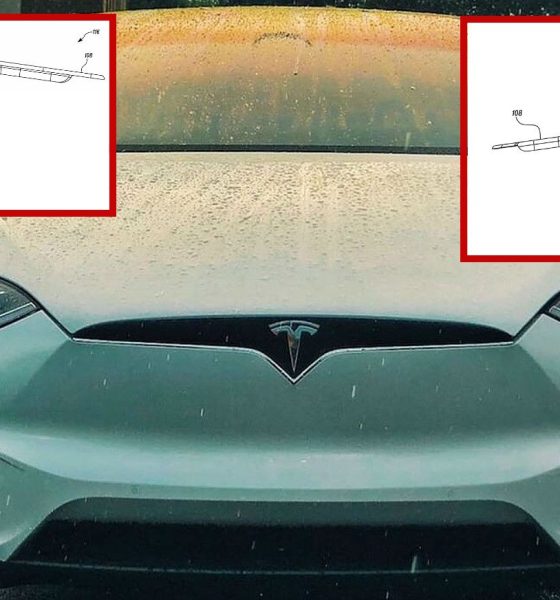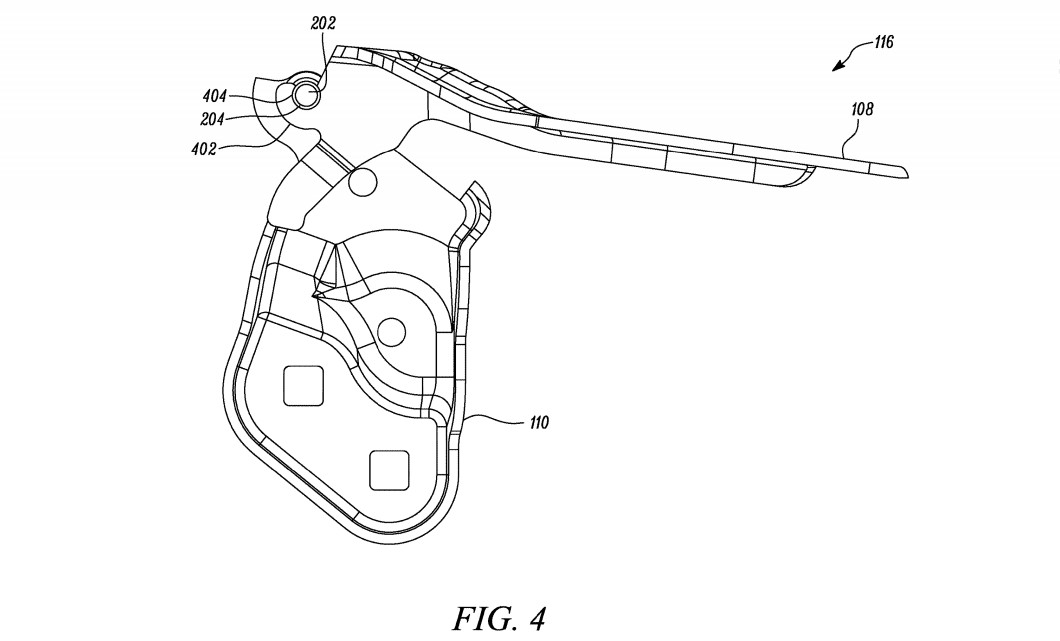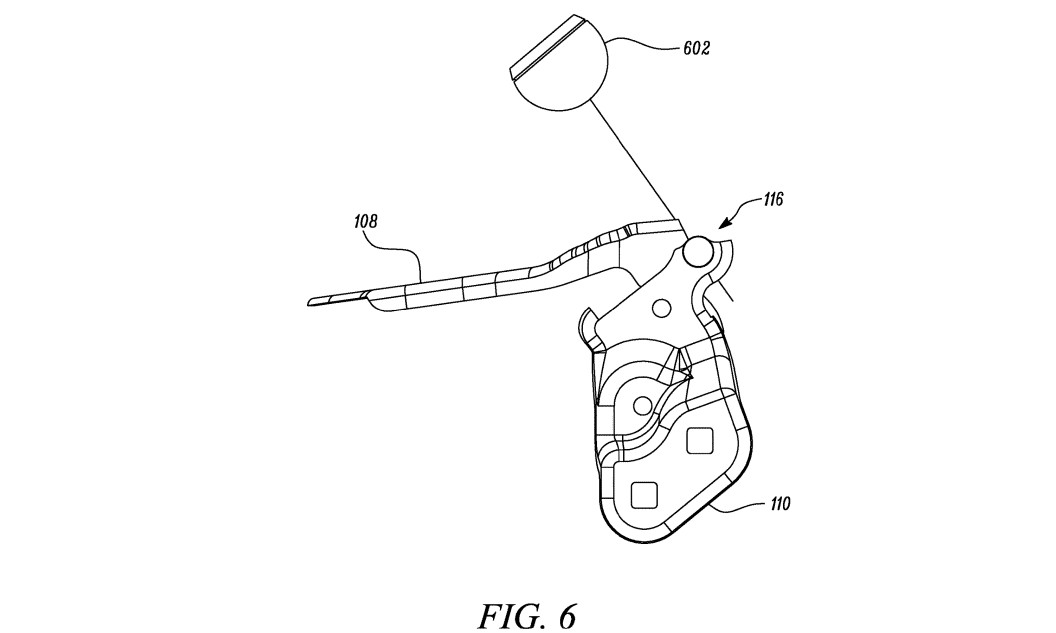

News
Tesla patents novel hood hinge that optimizes pedestrian safety during collisions
Tesla’s electric cars are known for being extremely quick, and they are also known for being extremely safe. The Model 3, the company’s most affordable car to date, for example, has aced safety ratings across the globe, earning a 5-Star rating from the NHTSA in the US, the Euro NCAP in Europe, and the ANCAP in Australia. Even the IIHS gave the Tesla Model 3 its highest rating, Top Safety Pick+.
But this is Tesla, and the electric car maker is known for being a company that refuses to stay still. Its cars are already quick enough to give passengers serious Gs while launching, yet the company remains hard at work on making them even quicker and more visceral in terms of speed (e.g. the Model S Plaid Powertrain). In the same light, while Teslas are already safe at their current state, it is no surprise that the company remains dedicated to finding ways to make its vehicles even safer, both for passengers in the cabin and for pedestrians on the road.
One such example of this was highlighted in a recently published patent that was simply titled “Hinge Assembly for a Vehicle Hood.” Based on the electric car maker’s discussion, the novel hinge assembly has the potential to protect pedestrians who happen to hit the vehicle’s hood during a collision. Similar systems are in place in vehicles today, though Tesla maintained that conventional designs have lots of areas for improvement.

“Modern vehicles are mandated by safety standards to protect pedestrians from head-impact injuries, including a scenario in which a pedestrian would contact the vehicle’s hood. To meet these requirements. Current state of the art safety systems are active systems that typically include a sensor system to detect a collision with pedestrian and fire (using a pyrotechnic) an actuator to lift the front hood into a protective position before pedestrian impact. However, such systems may be falsely triggered and can only be used once because the pyrotechnic is not reversible. The pyrotechnic is also expensive, adding to overall cost of the vehicle. Therefore, there is a need for a safety system that overcomes the aforementioned drawbacks.”
Tesla noted in its patent’s description that its hinge assembly includes a body member and a hood member, with the latter being “pivotally coupled with a body member through a pivot pin.” In the event of a collision, a portion of the vehicle’s hood member or body member “deforms such that the hood member or body member disengages from the pivot pin.” This allows Tesla to use the hinge as a passive pedestrian safety system that does not require any additional components such as sensors or controllers. The design outlined in Tesla’s patent is also more practical than the pyrotechnic system used in conventional pedestrian impact safety systems.
Tesla describes how its hood hinge works in a collision in the following section.

“FIG. 6 illustrates impact of a headform 602 on hinge assembly 116. Headform 602 represents the head (or portion thereof) of a pedestrian or other living being. As illustrated, when a collision occurs such that headform 602 hits a portion of hood member 108 of vehicle 100 along direction of an axis X-X′, a force is generated. When the force is great enough, the impact force causes hood member 108 to disengage from hinge assembly 116. The impact force typically causes deformation of portion 314 of hood member 108 adjacent to notch 312 such that pivot pin 202 disengages with second opening 304 of hood member 108. In embodiments, the width W of notch 312 is altered to change the impact force at which the hood member 108 disengages from hood member 108. In embodiments the impact force causes deformation of the pivot pin 202 to allow disengagement of hood member 108 from body member 110.
“In an event of collision, hood member 108 may disengage with hinge assembly 116 such that safety standards can be met. Hood member 108 may move down due to impact force and disengagement with hinge assembly 116. To allow movement of hood member 108, sufficient space may be provided by trimming away portions of hood member 108 and body member 110. Advantageously, this would lower weight of components while maintaining the safety standards for vehicle 100.”
Tesla is a carmaker that will likely never stay still. Despite its significant lead in the electric car segment thanks to its vehicles’ batteries and powertrain, Tesla is in a continuous process of improvement. The hood hinge outlined in this patent might be quite simple, but it contributes to the overall safety of Tesla’s lineup of vehicles nonetheless. Such initiatives, if any, further prove that when it comes to safety, no part is too small for innovation — and in the event of a collision, it’s these factors that can make all the difference.
Tesla’s patent for its hinge assembly could be accessed below.
Tesla Hood Patent by Simon Alvarez on Scribd

News
Tesla (TSLA) receives “Buy” rating and $551 PT from Canaccord Genuity
He also maintained a “Buy” rating for TSLA stock over the company’s improving long-term outlook, which is driven by autonomy and robotics.

Canaccord Genuity analyst George Gianarikas raised his Tesla (NASDAQ:TSLA) price target from $482 to $551. He also maintained a “Buy” rating for TSLA stock over the company’s improving long-term outlook, which is driven by autonomy and robotics.
The analyst’s updated note
Gianarikas lowered his 4Q25 delivery estimates but pointed to several positive factors in the Tesla story. He noted that EV adoption in emerging markets is gaining pace, and progress in FSD and the Robotaxi rollout in 2026 represent major upside drivers. Further progress in the Optimus program next year could also add more momentum for the electric vehicle maker.
“Overall, yes, 4Q25 delivery expectations are being revised lower. However, the reset in the US EV market is laying the groundwork for a more durable and attractive long-term demand environment.
“At the same time, EV penetration in emerging markets is accelerating, reinforcing Tesla’s potential multi‑year growth runway beyond the US. Global progress in FSD and the anticipated rollout of a larger robotaxi fleet in 2026 are increasingly important components of the Tesla equity story and could provide sentiment tailwinds,” the analyst wrote.
Tesla’s busy 2026
The upcoming year would be a busy one for Tesla, considering the company’s plans and targets. The autonomous two-seat Cybercab has been confirmed to start production sometime in Q2 2026, as per Elon Musk during the 2025 Annual Shareholder Meeting.
Apart from this, Tesla is also expected to unveil the next-generation Roadster on April 1, 2026. Tesla is also expected to start high-volume production of the Tesla Semi in Nevada next year.
Apart from vehicle launches, Tesla has expressed its intentions to significantly ramp the rollout of FSD to several regions worldwide, such as Europe. Plans are also underway to launch more Robotaxi networks in several more key areas across the United States.
News
Waymo sues Santa Monica over order to halt overnight charging sessions
In its complaint, Waymo argued that its self-driving cars’ operations do not constitute a public nuisance, and compliance with the city’s order would cause the company irreparable harm.

Waymo has filed a lawsuit against the City of Santa Monica in Los Angeles County Superior Court, seeking to block an order that requires the company to cease overnight charging at two facilities.
In its complaint, Waymo argued that its self-driving cars’ operations do not constitute a public nuisance, and compliance with the city’s order would cause the company irreparable harm.
Nuisance claims
As noted in a report from the Los Angeles Times, Waymo’s two charging sites at Euclid Street and Broadway have operated for about a year, supporting the company’s growing fleet with round-the-clock activity. Unfortunately, this has also resulted in residents in the area reportedly being unable to sleep due to incessant beeping from self-driving taxis that are moving in and out of the charging stations around the clock.
Frustrated residents have protested against the Waymos by blocking the vehicles’ paths, placing cones, and “stacking” cars to create backups. This has also resulted in multiple calls to the police.
Last month, the city issued an order to Waymo and its charging partner, Voltera, to cease overnight operations at the charging locations, stating that the self-driving vehicles’ activities at night were a public nuisance. A December 15 meeting yielded no agreement on mitigations like software rerouting. Waymo proposed changes, but the city reportedly insisted that nothing would satisfy the irate residents.
“We are disappointed that the City has chosen an adversarial path over a collaborative one. The City’s position has been to insist that no actions taken or proposed by Waymo would satisfy the complaining neighbors and therefore must be deemed insufficient,” a Waymo spokesperson stated.
Waymo pushes back
In its legal complaint, Waymo stated that its “activities at the Broadway Facilities do not constitute a public nuisance.” The company also noted that it “faces imminent and irreparable harm to its operations, employees, and customers” from the city’s order. The suit also stated that the city was fully aware that the Voltera charging sites would be operating around the clock to support Waymo’s self-driving taxis.
The company highlighted over one million trips in Santa Monica since launch, with more than 50,000 rides starting or ending there in November alone. Waymo also criticized the city for adopting a contentious strategy against businesses.
“The City of Santa Monica’s recent actions are inconsistent with its stated goal of attracting investment. At a time when the City faces a serious fiscal crisis, officials are choosing to obstruct properly permitted investment rather than fostering a ‘ready for business’ environment,” Waymo stated.
News
Tesla FSD v14.2.2 is getting rave reviews from drivers
So far, early testers have reported buttery-smooth drives with confident performance, even at night or on twisty roads.

Tesla Full Self-Driving (Supervised) v14.2.2 is receiving positive reviews from owners, with several drivers praising the build’s lack of hesitation during lane changes and its smoother decision-making, among others.
The update, which started rolling out on Monday, also adds features like dynamic arrival pin adjustment. So far, early testers have reported buttery-smooth drives with confident performance, even at night or on twisty roads.
Owners highlight major improvements
Longtime Tesla owner and FSD user @BLKMDL3 shared a detailed 10-hour impression of FSD v14.2.2, noting that the system exhibited “zero lane change hesitation” and “extremely refined” lane choices. He praised Mad Max mode’s performance, stellar parking in locations including ticket dispensers, and impressive canyon runs even in dark conditions.
Fellow FSD user Dan Burkland reported an hour of FSD v14.2.2’s nighttime driving with “zero hesitations” and “buttery smooth” confidence reminiscent of Robotaxi rides in areas such as Austin, Texas. Veteran FSD user Whole Mars Catalog also demonstrated voice navigation via Grok, while Tesla owner Devin Olsen completed a nearly two-hour drive with FSD v14.2.2 in heavy traffic and rain with strong performance.
Closer to unsupervised
FSD has been receiving rave reviews, even from Tesla’s competitors. Xpeng CEO He Xiaopeng, for one, offered fresh praise for FSD v14.2 after visiting Silicon Valley. Following extended test drives of Tesla vehicles running the latest FSD software, He stated that the system has made major strides, reinforcing his view that Tesla’s approach to autonomy is indeed the proper path towards autonomy.
According to He, Tesla’s FSD has evolved from a smooth Level 2 advanced driver assistance system into what he described as a “near-Level 4” experience in terms of capabilities. While acknowledging that areas of improvement are still present, the Xpeng CEO stated that FSD’s current iteration significantly surpasses last year’s capabilities. He also reiterated his belief that Tesla’s strategy of using the same autonomous software and hardware architecture across private vehicles and robotaxis is the right long-term approach, as it would allow users to bypass intermediate autonomy stages and move closer to Level 4 functionality.








